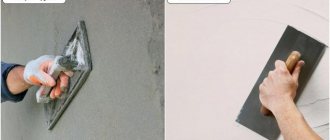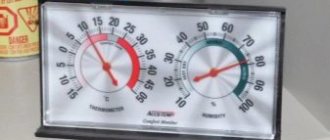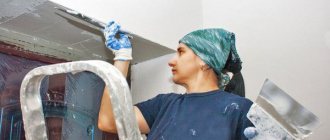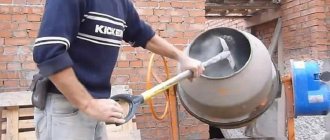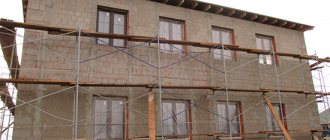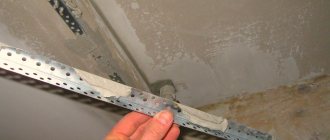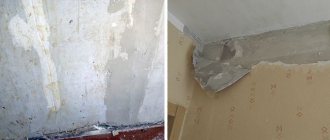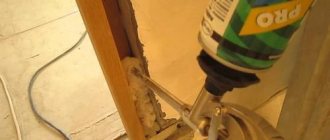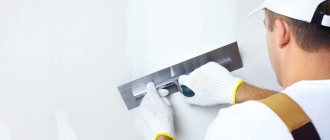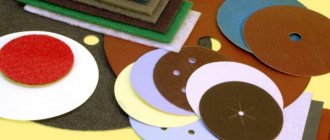Those who pick up a trowel or spatula for the first time, deciding to carry out repairs on their own, often cannot immediately decide: plaster and putty: what is the difference? Maybe they sell the same materials under different names in construction stores? And if different, can they be used for the same purposes? Let's get into the details.
What is the difference between plaster and putty?
Let's start our story with the most important difference between these building mixtures.
Plaster is intended for rough leveling of walls and is not suitable for finishing. Putty, in turn, is intended for preparing walls for finishing (painting, wallpapering, etc.), including after plastering.
The words “plaster” and “putty” came into the Russian language in different ways, both associated with the process of plastering. The first is of Italian origin (the word stucco was used to describe alabaster or gypsum, which was used to cover uneven walls, and stuccare - to plaster, to cover). “Putty” (or “putty”) comes from the German word “spatula” - a spatula - a tool used to perform leveling and filling.
plaster
It is difficult to establish when and how the division of the meaning of words occurred, but the difference exists. Let's see what plaster is.
This word means (depending on the context):
- building composition (dry or solution);
- the process of applying a solution (plastering walls, for example);
- finished coating.
The word “putty” means: composition, process, coating layer. So far we haven't seen any differences. The difference is related to the purpose of finishing, its composition, scope of application, and the sequence of work. As a result, the putty surface is easy to distinguish tactilely and visually.
putty
The main difference between the plaster mixture is the presence of sand filler in the composition. The exception is the Venetian, where stone flour is used as a filler. Let's look at the composition from different aspects carefully and find that there are more differences.
Compound
Plaster compositions are used for two purposes - protective and aesthetic. For example, for leveling curvature and monolithing walls, sealing joints, and repairing cracks.
There are several types of compositions:
- conventional (for rough processing, for example, leveling, monolining);
- decorative (in the first position are properties that contribute to the creation of various visual effects);
- special (protective functions - thermal insulation, waterproofing, sound insulation, etc.).
The plaster composition includes several main components:
- a binder (one or two, less often more), connecting other components, hardening by polymerization or crystallization;
- filler - granular or fibrous inert material that creates a structure that affects strength (as well as other physical properties) and decorative qualities;
- solvent – water (for complex polymer compositions this may be other substances);
- modifying additives (increasing adhesion, resistance to fungus, plasticity) or decorating (mother of pearl, flocks, metal dust).
components of plaster and putty composition
For leveling (rough mixtures) two types of mineral binders are most often used: gypsum (for interior decoration); cement (universal use). The strength properties, features of the technology of preparation, application, hardening, and operation depend on the type of binder. Other binders are used less frequently because the price is higher.
Scope of use
The listed materials are used to correct varying degrees of curvature of surfaces. This was discussed a little above. Now more details.
If plaster is used to correct differences of about 50 mm (to level differences of more than 30 mm, reinforced mesh or “Concrete Contact” is additionally used), then putty is used to level differences of no more than 10 mm. Plaster, as we discussed above, is applied in a thick and dense layer, while putty is subject to delamination when applied in a similar manner.
Subsequence
Above we looked at the main difference between plaster and putty and drew attention to the methods of applying them and the main features. It would not be amiss to consider another very important issue - the interaction of these materials on the same surface. We will talk about using solutions simultaneously, that is, about applying the mixtures one by one.
Let's consider three options:
- The surface is very uneven, with large deviations and cracks. Our actions: cleaning from debris and dust, priming, single or multi-layer plastering (depending on the degree of unevenness), drying, priming and treatment with putty.
What comes first: plaster or putty?
If we consider what is applied to the wall first: plaster or putty, then the order should not be confused. A construction rule helps to understand and remember the sequence; failure to comply with it leads to defects.
The rule is as follows: a weak coating is applied to a strong base.
That is, a stronger coating cannot be applied to a weak wall, because it will come off along with part of the top of the underlying material. This often happens already during the curing stage. Plaster coating is always made more durable than putty. If you plaster over putty, the hardening top layer will tend to “shrink,” which the less durable putty base cannot resist. The resulting stresses will cause pieces of the hard finish to crack and fall off.
first apply plaster then putty
If you first plaster the wall and then apply putty, the putty will not fall off or crack.
Properties of solutions
The main properties of putty compositions include:
- maintaining volume after drying;
- moderate viscosity;
- resistance to cracking and peeling.
Plaster compositions boast the following characteristics:
- good adhesive properties, due to which the solution reliably adheres to the base;
- good ductility;
- high resistance (after drying) to mechanical loads;
- possibility of applying a thick layer.
Thus, we can conclude that putty and plaster are very different from each other in composition, properties and scope of application. But that's not all. The methods for applying such solutions also differ from each other. What are the differences? Read about it below.
What should plaster walls look like before applying putty?
As already explained, plaster mortar is used to level bases with large differences in height and serious defects. Taking into account the thickness of the putty layer - 2 mm, the surface of the plaster coating intended for puttying is leveled by covering and rubbing the surface. If necessary, the surface of the plaster is sanded (a difficult task due to the strength of the material).
Before performing puttying, you need to make sure: the surface must be dry and clean (no stains). Be sure to prime the surface before puttingty. Priming clogs pores and increases adhesive properties.
As a result, after puttying, the surface ready for painting should look even, uniform (without stains), smooth and dry.
Differences in work, application methods
The most important difference is in the methods of applying these finishing materials. To understand the essence of the issue, it is necessary to consider the methods in more detail.
Plaster
- A mixture of cement and sand is applied in a thick layer, after first freeing the surface from the remnants of the old cladding, and it must be cleaned and primed. You can find out more about how to remove liquid wallpaper from walls and how to remove glue from stickers.
- The amount of mixture and layers depends on the unevenness of the surface. We apply the solution with a trowel (trowel) with a little force, applying it to the wall to improve adhesion to the surface.
- Using fixed beacons, using building rules, the mortar is leveled and residues are removed.
NOTE! If the curvature of the surface is very strong, then it is necessary to apply at least three layers of the mixture, allowing each layer to harden well. In case of strong unevenness, it is worth resorting to the help of reinforced mesh.
The gypsum mixture is applied as if by spreading, since it has great elasticity and plasticity. However, the procedure can be carried out by machine, which significantly increases productivity. In this option, the mixture is supplied under a certain pressure to the base of the wall, which guarantees high-quality adhesion. But there is no escape from manual smoothing.
putty
The mixture has its own characteristics in operation. Apply and stretch it in a thin layer, placing it directly on the tool (wide spatula), and not on the surface of the wall. Let us repeat that putty is used to cover cracks and smooth out minor unevenness in the base.
When not to putty
Not every plaster coating needs to be puttied. For example, you can get by with plaster if the finishing touch is to cover the wall with tiles, PVC panels and other sheet (rigid) materials. Also, finishing with decorative plaster, which can partially hide defects, is not required.
tiles in the bathroom
The subject of this article is the question “plaster and putty: what is the difference.” We found that the difference begins with the difference in the purpose of using the two types of finishing work. It determines the differences in the rest. There are separate interchangeability options.
Areas of use
Having examined the difference between putty and plaster, we move directly to the area of their application in repairs. The following methods are distinguished:
- leveling walls;
- restoration;
- decorative finishing.
In the first case, application occurs in one or several layers 2-3 mm thick. The remaining finishing is final.
Finishing
Alignment of walls
Some tips for leveling walls:
- Calculate the level of the wall (using a stretched string). Small irregularities do not require the installation of beacons.
- Initially, putty only the problem areas, then pull the mixture with a spatula. Afterwards the finishing putty is applied to the wall.
- The wall is cleaned with sandpaper.
Alignment of walls
Restoration and decorative finishing
Continuing the topic of how plaster differs from putty, we will look at restoration and decorative finishing of walls. The most significant and obvious cause of defects is initially incorrect application of plaster to the wall. If finishing work was carried out in hot, dry weather and the surface was not wetted, be sure to expect small cracks throughout the entire area. To achieve this, restoration is carried out using decorative finishing.
Decorative wall decoration
Repair with decorative plaster consists of sealing cracks and chips with fresh mortar. Follow these rules, otherwise chips and breaks will soon appear again:
- Pick out the crack (it is permissible to remove undamaged material).
- Knock down the peeling areas, clean off all the plaster for a stronger adhesion to the wall of the new layer. To prevent the finish from coming off, moisten it with warm water.
- Apply decorative plaster with a spatula from top to bottom and rub in. If the mixture has not been tinted, sand it additionally. Give the area a rectangular shape - later it will be less noticeable. Place reinforced tape into the crack for strength.
The main differences between plaster: cement and gypsum.
Both the rough version and the final finishing, the popular cement-sand mixture can be used for a variety of purposes. The use of gypsum mixtures with excellent characteristics has only recently gained momentum. Let's look at both of these building materials.
Price. There are no significant differences. Due to the lower weight required per 1 square meter, the price is approximately the same, even taking into account the more expensive cost of this material.
Length of time of use. In these characteristics, gypsum is significantly inferior. Its setting time is quite short - 45-90 minutes. Only mixtures prepared for application by machine can “last” for about 120 minutes. While the stable average lifespan of a cement mixture is about 120 minutes.
There are no fundamental differences in the durability and vapor permeability of gypsum and cement plasters.
Thermal conductivity. Typically, cement coatings feel cooler to the touch and cure in less time.
Application area. Plaster is used exclusively for interior work. While the cement mixture allows for both external and internal work.
Aesthetic appearance. Plastic gypsum mass allows craftsmen to create a variety of textures, predetermined by the composition, or made by hand.
